Protect Python Code 🛡️#
ℹ Introduction#
Python scripts can be protected in order to avoid stealing intellectual property, algorithms or anything else you want to hide from the final user. As using an interpreter (usually CPython), your code is translated from human readable language (python) in python bytecodes (stored in __pycache__) by the computer of the user; with some modifications of CPython source code, you could extract all the code (even if it’s obfuscated) without difficulties. The solution provided here does work only with Windows. But you could use Wine on Linux to run the binaries.
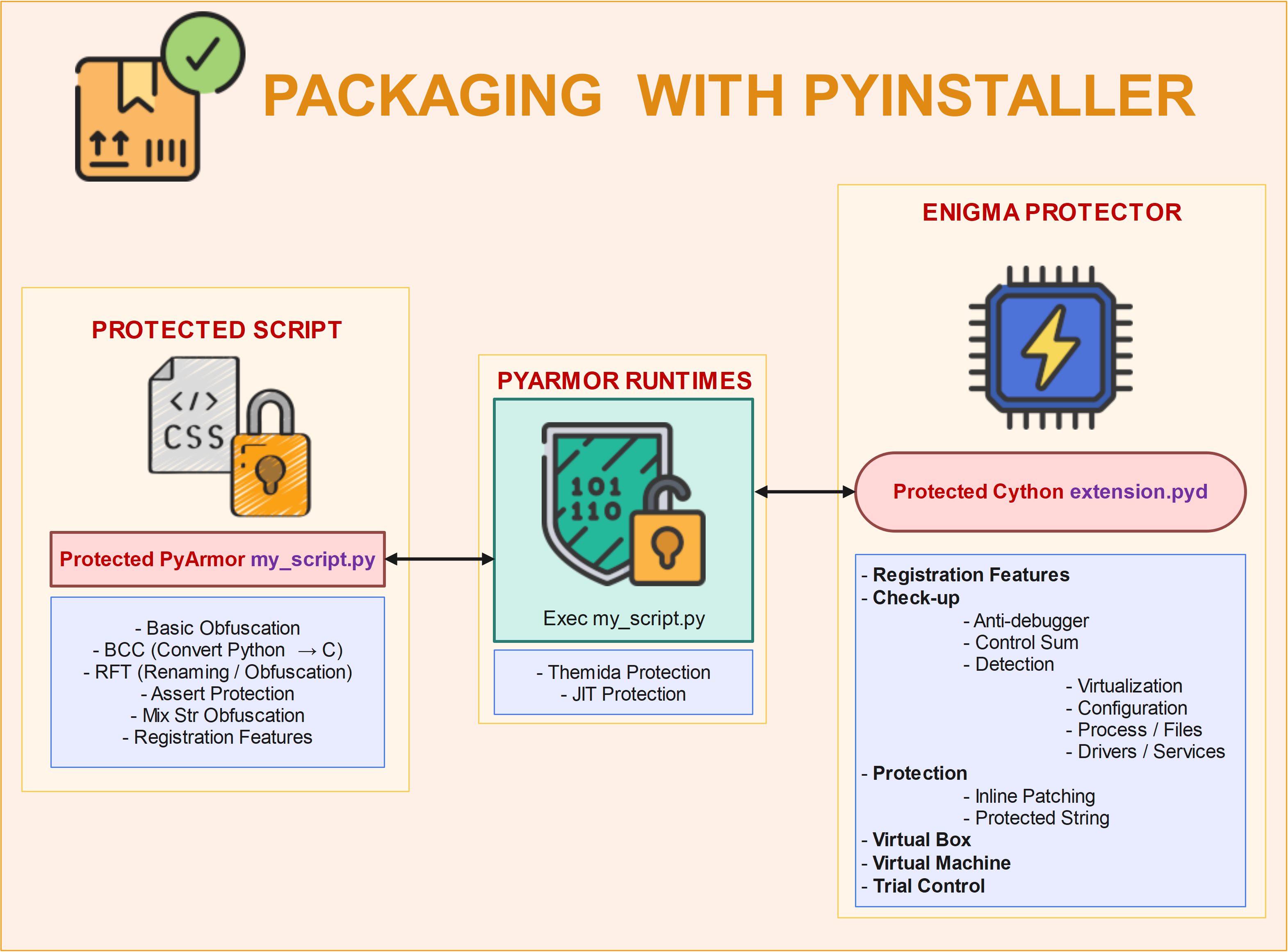
How to dump code object to disk ?
Compile Python from the source. Modify the _PyEval_EvalFrameDefault function such that it dumps the code object to disk.
In this note, I propose a strong way of protecting your python scripts. Python Script will be obfuscated by a tool named PyArmor which relies on an external unknown not open-source library. The essential algorithms/functions will be translated in C++ by Cython which will provide a Dynamic Link Library which will be protected by Enigma Protector and called by our Python script. All the program will be packed with PyInstaller.
🔧 Requirements#
Enigma Protector - 200 € In order to compile, you need to move two files in your project from the sdk/VC path of Enigma Protector. File 1 :
enigma_ide.hFile 2 :enigma_ide64.lib
In enigma_ide.h, just insert the following line.
#include <windows.h>
PyArmor - 100 €
pip install pyarmor
pyarmor register pyarmor-regfile-1.zip
pyarmor -v
Pyarmor 8.1.9 (pro), 00XXXX, XXXXXXXX
License Type : pyarmor-pro
License No. : pyarmor-vax-00XXXX
License To : XXXXXXXX (Rémi MEVAERE)
BCC Mode : Yes
RFT Mode : Yes
Notes
* Internet connection is required to verify Pyarmor license
pip install cython
pip install pyinstaller
choco install upx
⚙️Process#
🔨 Building protected extension.pyd#
🏎️ Cython testing#
About Cython
Cython is a programming language that aims to be a superset of the Python programming language, designed to give C-like performance with code that is written mostly in Python with optional additional C-inspired syntax. Cython is a compiled language that is typically used to generate CPython extension modules.
Cython could generate with your Python code a c++ file which could be compiled in a dynamic link library (DLL) which could be directly called by your python code.
The first file is the python file script you want to convert in C. Please note the extension .pyx.
File : fib.pyx
# cython: language_level=3
def fib(n):
"""Print the Fibonacci series up to n."""
a, b = 0, 1
while b < n:
print(b, end=' ')
a, b = b, a + b
print()
Now we need to create the setup.py, which is a python Makefile (for more information
see Source Files and Compilation
File : setup.py
from setuptools import setup
from Cython.Build import cythonize
setup(
ext_modules=cythonize("fib.pyx"),
)
Run the following command :
python setup.py build_ext --inplace
It converts it in c and compile with msvc in fib.cp311-win_amd64.pyd

DLL Export Viewer tells us this is a valid DLL
import fib
fib.fib(50000000) # will give the expected result
🔮 Enigma Protector#
The goal is to protect your python app, and especially here with Enigma Protector your extension in .pyd. In order to do this, you will need :
some of your most important code into a
.pyx filewhich will be converted inc++, this code will be protected ;protect the DLL produced by cython with enigma protector ;
Use it !
Important
C compiled files are faster than python cause they don’t deal with python object structure. C files are also faster when they deal with loops, and cause they don’t deal with the GIL, cython gives you the opportunity to use all your CPU cores.
Avertissement
Be careful, GIL exists to avoid some complex problem with memory access to shared variables and handle correctly garbage collector.
⚒ Tuning before compilation#
Here we are working with a c++ file. It doesn’t change a lot except in setup.py.
File : setup.py
from setuptools import setup, Extension
from Cython.Distutils import build_ext
setup(
name='Test app',
ext_modules=[
Extension('test_it',
sources=['script_test.pyx'],
extra_link_args=['/MAP'],
libraries=["enigma_ide64"],
language="c++")
],
cmdclass={'build_ext': build_ext}
)
👓 API Studying#
I will not copy all the manual in this article, if you want more informations about the API please read the manual.
A ==Marker== is a set of bytes placed into the source code and helping Enigma Protector find the code inside markers for processing. A marker consists of two parts: begin marker and end marker.
// Markers API
__declspec(dllimport) void __stdcall EP_Marker(const char*);
==EP_RegHardware== function serves for retrieving unique user PC information. The function does not have parameters. If the function succeeds, the return value is a pointer to the null-terminated ANSI string. If the function fails, the return value is 0.
// Registration API
__declspec(dllimport) char* __stdcall EP_RegHardwareID();
__declspec(dllimport) wchar_t* __stdcall EP_RegHardwareIDW();
==EP_RegKeyStatus== EP_RegKeyStatus returns the error status of registration information after the key verification routine. It should be called after any function that verifies registration information, for example, after EP_RegCheckKey or EP_RegLoadAndCheckKey.
__declspec(dllimport) int __stdcall EP_RegKeyStatus();
==EP_RegCheckAndSaveKeyW== function serves for verifying and saving the registration information. It has the same functionality as EP_RegCheckAndSaveKey, but is used for processing Unicode (wide) strings data. Please note, to use this function you should enable UNICODE Registration Scheme at REGISTRATION FEATURES - Common panel.
__declspec(dllimport) BOOL __stdcall EP_RegCheckAndSaveKeyW( const wchar_t* Name, const wchar_t* Key );
==EP_RegDeleteKey== function serves for deleting the existing registration information.
__declspec(dllimport) BOOL __stdcall EP_RegDeleteKey();
==EP_ProtectedString== function returns protected strings. See also Protection Features - Protected Strings.
__declspec(dllimport) int __stdcall EP_ProtectedStringByID( int ID, const char* Str, int Len);
__declspec(dllimport) int __stdcall EP_ProtectedStringByKey( const char* Key, const char* Str, int Len);
🎇 Using Widestring Char (Unicode) in Cython - wchar_t*#
Because the API exposes two kinds of function. One AnsiString and one WideString, please consider the following code to work with ==WideString==.
# Imports and declaration to work fromWideChar
from cpython.ref cimport PyObject
from libc.stddef cimport wchar_t
cdef extern from "Python.h":
PyObject * PyUnicode_FromWideChar(wchar_t *w, Py_ssize_t size)
# import functions
cdef extern from "enigma_ide.h":
void EP_Marker(char* Name)
char* EP_RegHardwareID()
wchar_t * EP_RegHardwareIDW()
cdef PyObject * pystr = PyUnicode_FromWideChar(EP_RegHardwareIDW(), -1)
wide_str_hid = str(<object> pystr)
print('WideChar :', wide_str_hid)
> WideChar : 02EF34-F57F02
🗜️RISC Markers Virtualization#
File : script_test.pyx
# distutils: language = c++
# cython: language_level=3
# import functions
cdef extern from "enigma_ide.h":
void EP_Marker(char* Name)
# Declare a trivial function
def sum_it(number1, number2):
return number1 + number2
# Protect this with RISC virtualization
EP_Marker("vm_risc_begin")
a = 4
b = 7
c = a + b
print('Virtualized :', c)
EP_Marker("vm_risc_end")
# Classic python code
print("Give me the sum :", sum_it(1, 2))
input("End, press key")
Convert and build with msvc
python setup.py build_ext --inplace

The protected module and his functions are callable like any other module in python. So in our program we will load this extension.pyd like any other package/module.
Exemple : importing test_it will run the module init code.
import test_it
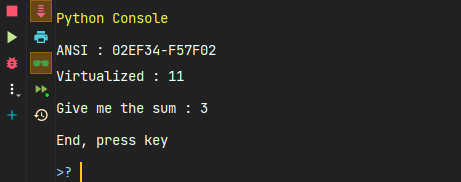
🗜️Choose function to Virtualize#
Need
extra_link_args=['/MAP']insetup.pyVirtual Machine → Functions Selecting → Add Functions
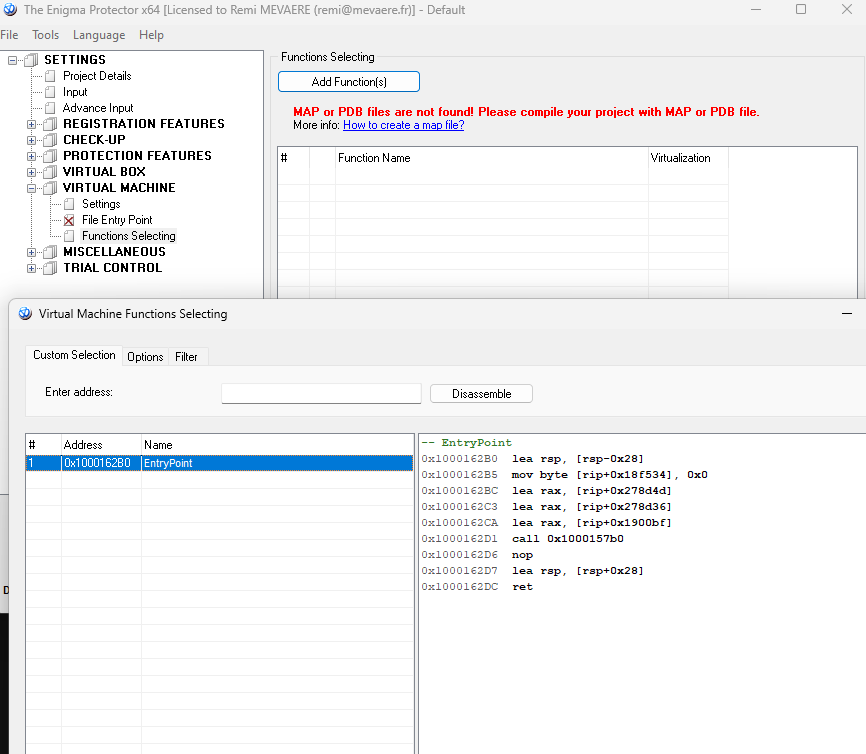
In order for a function to be visible in Enigma Protector, it’s important to mark the function public
cpdef public int ma_fonction_A(int number1, int number2):
print("Welcome in function A")
cdef int number3
number3 = int(input("Give me a number :"))
return number1 + number2 + number3
🔏 Registration feature#
🖲️Get Hardware ID#
# distutils: language = c++
# cython: language_level=3
import cython
from cpython.ref cimport PyObject
from libc.stddef cimport wchar_t
cdef extern from "Python.h":
PyObject * PyUnicode_FromWideChar(wchar_t *w, Py_ssize_t size)
wchar_t * PyUnicode_AsWideCharString(object, Py_ssize_t *)
cdef extern from "enigma_ide.h":
char * EP_RegHardwareID()
wchar_t * EP_RegHardwareIDW()
# ANSI
ansi_str_hid = str(EP_RegHardwareID(), 'cp1252')
print('EP_RegHardwareID :', ansi_str_hid)
# WIDE
cdef PyObject * pystr
pystr = PyUnicode_FromWideChar(EP_RegHardwareIDW(), -1)
wide_str_hid = str(<object> pystr)
print('EP_RegHardwareWide :', wide_str_hid)
🔓Register software#
First you need to generate a key, please note that in this article I will use WideChar (Unicode in configuration). It’s more complex than ANSI, if you understand with Unicode, it will be straightforward for ANSI.
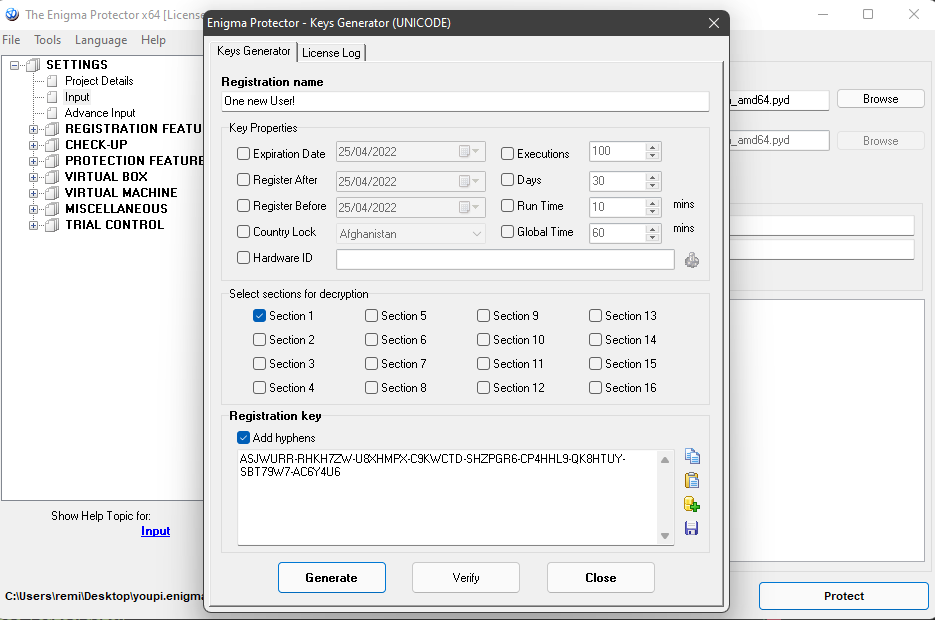
# distutils: language = c++
# cython: language_level=3
import cython
from cpython.ref cimport PyObject
from libc.stddef cimport wchar_t
from libcpp cimport bool
cdef extern from "Python.h":
PyObject * PyUnicode_FromWideChar(wchar_t *w, Py_ssize_t size)
wchar_t * PyUnicode_AsWideCharString(object, Py_ssize_t *)
cdef extern from "enigma_ide.h":
bool EP_RegCheckAndSaveKeyW(wchar_t * Name, wchar_t * Key)
reg_name = input("Name :")
reg_key = input("Key :")
cdef wchar_t *reg_name_wchar
cdef wchar_t *reg_key_wchar
cdef Py_ssize_t length
reg_name = u"Test-WrongUSER"
reg_key = u"CKML369-XGSH5DW-RVG2ANU-W4FG4K4-J2RQYHM-32SD3LD-XJPKSYB-S5RPPPE-SEURZXQ"
reg_name_wchar = PyUnicode_AsWideCharString(reg_name, &length)
reg_key_wchar = PyUnicode_AsWideCharString(reg_key, &length)
print("Registration to : ", reg_name)
if EP_RegCheckAndSaveKeyW(reg_name_wchar, reg_key_wchar):
print("Registration OK, please restart APP")
quit()
else:
print("Registration ERROR")
🪟Registration dialog#
If you want to use the registration dialog just use the dedicated API
cdef extern from "enigma_ide.h":
void EP_RegShowDialog()
if not registered:
EP_RegShowDialog()
🪄 Registration status#
# distutils: language = c++
# cython: language_level=3
import cython
from cpython.ref cimport PyObject
from libc.stddef cimport wchar_t
cdef extern from "enigma_ide.h":
int EP_RegKeyStatus()
if EP_RegKeyStatus() == 1:
print("You are registered")
else:
print("You are NOT registered")
🔐Locking function from registration#
# distutils: language = c++
# cython: language_level=3
import cython
cdef extern from "enigma_ide.h":
void EP_Marker(char * Name)
cdef public int ma_fonction_B(int number1, int number2):
cdef int number3
# If the user is registered and the key allow block 6
EP_Marker("reg_crypt_begin6")
print("Welcome to the registered and crypted part 6")
number3 = int(input("Give me a number :"))
EP_Marker("reg_crypt_end6")
# If the user is not registered or doesn't allow block 6
EP_Marker("unreg_crypt_begin6")
print("Welcome to the unregistered part 6")
number3 = 8
EP_Marker("unreg_crypt_end6")
return number1 - number2 - number3
❌ Delete registration#
# distutils: language = c++
# cython: language_level=3
import cython
from libcpp cimport bool
cdef extern from "enigma_ide.h":
bool EP_RegDeleteKey()
if EP_RegDeleteKey() == 1:
print("Deletion of registration OK")
🗃️ File virtualization#
It’s possible to hide some files inside the executable. You will access to these files directly from your script.
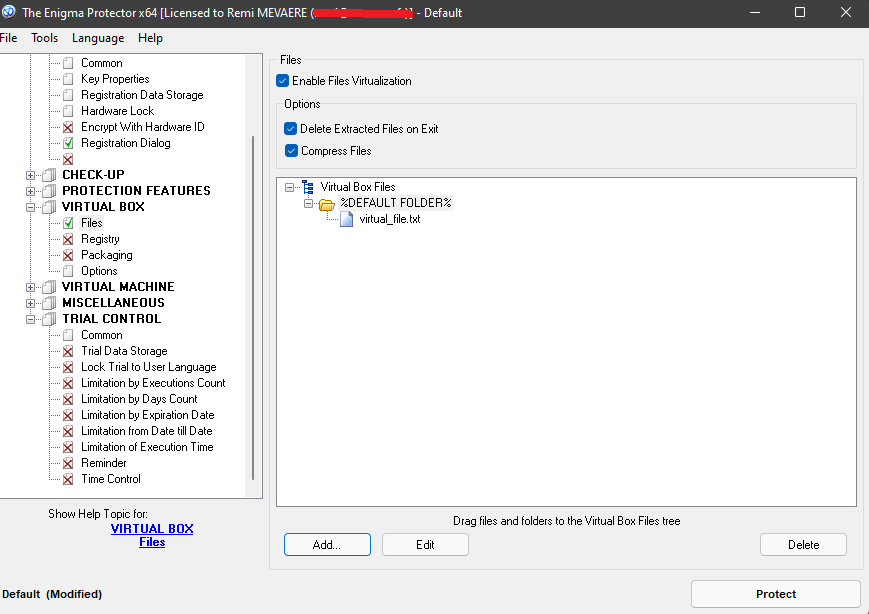
Add a file virtual_file.txt with some text
You could read the file with python easily :
with open('virtual_file.txt') as f:
lines = f.readlines()
print("------- virtual_file.txt -------")
print(lines)
print("--------------------------------")
🧵 Protected strings#
You can add some sensible protected strings in your code. We will see in this section how to retrieve them :
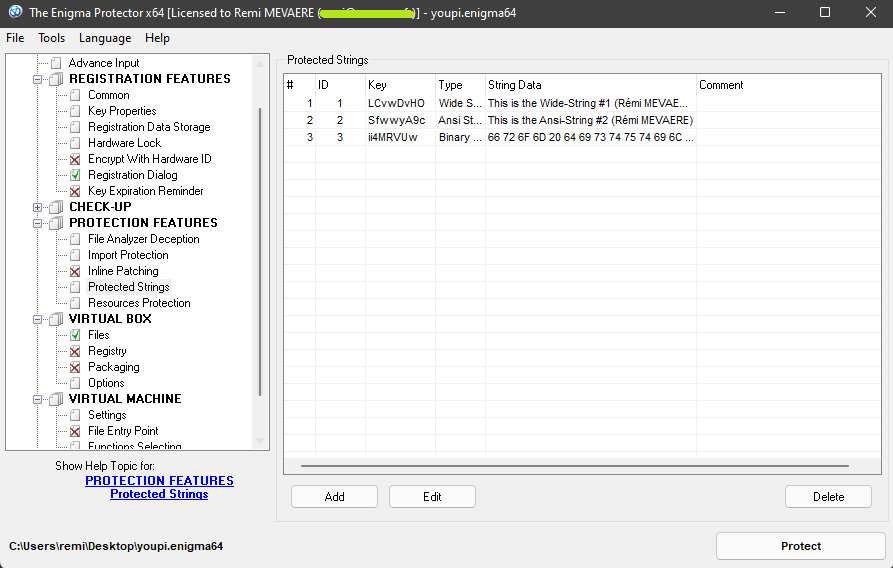
Add some strings in Enigma Protector
🧶 Ansistring#
ID#
import cython
from libc.stdlib cimport malloc, free
from cpython.bytes cimport PyBytes_FromStringAndSize
cdef extern from "enigma_ide.h":
int EP_ProtectedStringByID(int ID, char * Buffer, int Len)
cdef char * buf_string_2
buf_size_2 = EP_ProtectedStringByID(2, b'', 0)
print("Size of the string #2: ", buf_size_2)
buf_string_2 = <char *> malloc((buf_size_2) * sizeof(char))
if EP_ProtectedStringByID(2, buf_string_2, buf_size_2) != 0:
py_bytes = PyBytes_FromStringAndSize(<char *> buf_string_2, buf_size_2)
ansi_string = py_bytes.decode('windows-1252')
print('AnsiString :', ansi_string)
else:
print("Error can't extract #2")
free(buf_string_2)
Key#
import cython
from libc.stdlib cimport malloc, free
cdef extern from "enigma_ide.h":
int EP_ProtectedStringByKey(char * Key, char * Left, int Len)
cdef char * buf_string_2
buf_size = EP_ProtectedStringByKey("tckQpD9z", b'', 0)
print("Size of the string #1: ", buf_size)
buf_string_2 = <char *> malloc((buf_size + 1) * sizeof(char))
if EP_ProtectedStringByKey("tckQpD9z", buf_string_2, buf_size) != 0:
buf_string_2[buf_size] = b'\0'
print(str(buf_string_2, 'cp1252'))
else:
print("Error can't extract #1")
free(buf_string_2)
🪢 Widestring#
import cython
from cpython.ref cimport PyObject
from libc.stddef cimport wchar_t
from libc.stdlib cimport malloc, free
from cpython.bytes cimport PyBytes_FromStringAndSize
cdef extern from "enigma_ide.h":
int EP_ProtectedStringByID(int ID, char * Buffer, int Len)
buf_size = EP_ProtectedStringByID(1, b'', 0)
print("Size of the string #1: ", buf_size)
cdef wchar_t * buf_string
if buf_size > 0:
buf_string = <wchar_t *> malloc(buf_size)
if not buf_string:
raise MemoryError("Failed to allocate memory")
EP_ProtectedStringByID(1, <char *> buf_string, buf_size)
py_bytes = PyBytes_FromStringAndSize(<char *>buf_string, buf_size)
wide_string = py_bytes.decode('utf-16')
print('WideString :', wide_string)
free(buf_string)
💾 Binary#
import cython
from cpython.ref cimport PyObject
from libc.stdlib cimport malloc, free
cdef extern from "enigma_ide.h":
int EP_ProtectedStringByKey(char * Key, char * Left, int Len)
cdef char * buf_string_2
buf_size = EP_ProtectedStringByID(3, b'', 0)
print("Size of the string #3: ", buf_size)
buf_string_2 = <char *> malloc((buf_size + 1) * sizeof(char))
if EP_ProtectedStringByID(3, buf_string_2, buf_size) != 0:
print(str(buf_string_2))
else:
print("Error can't extract #3")
free(buf_string_2)
✒️Signing extension.pyd#
Advantage for signing code :
Validates code integrity
Issuing company reputation and authenticity
Safe and secure user experience
Seamless integration with multiple platforms
On my side, I have a certificate issue from Sectigo
signtool sign /fd SHA256 /n "Rémi MEVAERE" /t http://timestamp.digicert.com .\cython_protect.cp311-win_amd64.pyd
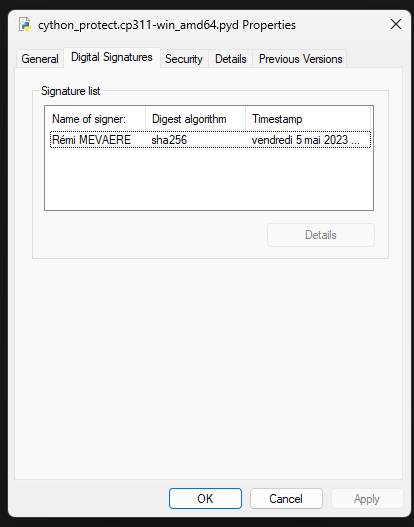
🛡Building protected my_script.py#
♾️Informations#
Current features of ==PyArmor 8+==
OS |
Windows |
Apple |
Linux |
|||||
|---|---|---|---|---|---|---|---|---|
Arch |
x86/x86_64 |
x86_64 |
arm64 |
arm64 |
x86/x86_64 |
aarch64 |
armv7 |
armv6 |
Themida Protection |
Y |
No |
No |
No |
No |
No |
No |
No |
RFT Mode |
Y |
Y |
Y |
Y |
Y |
Y |
Y |
No |
BCC Mode |
Y |
Y |
Y |
Y |
Y |
Y |
Futur |
No |
Others |
Y |
Y |
Y |
Y |
Y |
Y |
Y |
No |
pyarmor-7 |
Y |
Y |
Y |
Y |
Y |
Y |
Y |
Y |
PyArmor only work with the interpreter (version) used by your script. So be sure that the final user are using the same interpreter. One way is to packed python with
PyInstaller.
📄 Our script#
The program we want to protect is composed of two scripts. If we want to use and load our extension.pyd just load like any other module.
File : main.py
from fibonacci import fibonacci
print("Welcome to the test program")
nbr = input("Please enter an integer : ")
if None != (fib_list := fibonacci(nbr)):
print("Sequence of Fibonacci : ")
print(fib_list)
input("Press key to stop")
File : fibonacci.py
def fibonacci(n):
try:
nbr = int(n)
if nbr <= 0:
raise ValueError
FibArray = [0, 1]
for i in range(nbr - 2):
FibArray.append(FibArray[-1] + FibArray[-2])
return FibArray
except:
print("Incorrect input")
return None
📜 Obfuscating one script#
First we want to protect the script fibonacci.py to see what’s happening.
pyarmor gen fibonacci.py

The obfuscated fibonacci.py is :
from pyarmor_runtime_005107 import __pyarmor__
__pyarmor__(__name__, __file__, b'PY005107\x00\x03\x0b\x00\xa7\r\r\n\x80\x00\x01\x00\x08\x00\x00\x00\x04\x00\x
... ... ... ... ... ... ... ... ... ... ... ... ... ... ... ... ... ...
"\xcf\x8d)mO\xfa\xe7\x04\xc8\xfeZ\xf6K\xf6,F\x14k\xbd\x07\x1e\xf5\x12\xf97=!\xb0`'")
And pyarmor_runtime.pyd is integrated in the dist folder. Let’s see what contains pyarmor_runtime.pyd, it’s an executable from PyArmor. Not open-source.

The program main.py works as expected :
(pyarmor-cython-py3.11) D:\JetBrainsProjects\PyCharm\PyArmor_Cython\dist>python main.py
Welcome to the test program
Please enter an integer : 55
Sequence of Fibonacci :
[0, 1, 1, 2, 3, 5, 8, 13, 21, 34, 55, 89, 144, 233, 377, 610, 987, 1597, 2584, 4181, 6765, 10946, 17711, 28657, 46368, 75025, 121393, 196418, 317811, 514229, 832
040, 1346269, 2178309, 3524578, 5702887, 9227465, 14930352, 24157817, 39088169, 63245986, 102334155, 165580141, 267914296, 433494437, 701408733, 1134903170, 1836311903, 2971215073, 4807526976, 7778742049, 12586269025, 20365011074, 32951280099, 53316291173, 86267571272]
Press key to stop
The key needed to read/decrypt/deobfuscate fibonacci.py is directly included in the PyArmor_Runtimes package.
📜 Obfuscating multiple script#
pyarmor gen main.py fibonacci.py
The program main.py will works as expected.
🥽 Protecting features#
Activate the mode you desire.
--obf-module <0,1> # enable all module 1
--obf-code <0,1,2> # Obfuscation mode (best is 2)
--enable <jit,rft,bcc,themida>
--enable-jit # Use JIT to process some sensitive data to improve security
--enable-rft # renaming function/class in the scripts
--enable-bcc # converting Python functions to C functions
--enable-themida # Use Themida to protect runtime package
--mix-str # Mix the string constant in scripts
--assert-call # Assert function is obfuscated
--assert-import # Assert module is obfuscated
--period N # Check Runtime Key periodically.
🗝️Excluding Key and binding to user#
In most cases, it’s better to not include the key into runtimes, but provide it and personnalized it for each user. PyArmor gives us some nice options.
‼️ Excluding Key#
Change the name of the licence file#
pyarmor cfg outer_keyname="my_licence.key"
Don’t include the key#
pyarmor gen main.py fibonacci.py --outer
And expected behavior :
> (venv) D:\JetBrainsProjects\PyCharm\PyArmorV2\dist>python main.py
> Traceback (most recent call last):
> File "D:\JetBrainsProjects\PyCharm\PyArmorV2\dist\main.py", line 2, in <module>
> from pyarmor_runtime_005107 import __pyarmor__
> File "D:\JetBrainsProjects\PyCharm\PyArmorV2\dist\pyarmor_runtime_005107\__init__.py", line 2, in <module>
> from .pyarmor_runtime import __pyarmor__
> RuntimeError: missing license key to run the script (1:10251)
🔑 Generate Key#
Syntax#
pyarmor gen key <options>
# Options
# -O PATH, --output PATH
# -e DATE, --expired DATE
# --period N
# -b DEV, --bind-device DEV
# --bind-data, store data
Bind device
$ pyarmor gen key -b 128.16.4.10 # IP
$ pyarmor gen key -b 52:38:6a:f2:c2:ff # MAC ADDRESS
$ pyarmor gen key -b HXS2000CN2A # SERIAL NUMBER OF DISK
$ pyarmor gen key -e 30 # 30 Days / Check NTP SERVER
$ pyarmor gen key -e .2022-12-31 # Date / Don't Check NTP SERVER (see .)
$ pyarmor gen key --period 1 # check every 1hour
$ pyarmor gen key --period 3600s # check every 1hour
$ pyarmor gen key --period 60m # check every 1hour
$ pyarmor gen key --period 1h # check every 1hour
$ pyarmor gen key --bind-data "Licensed to Rémi"
Generating a key
pyarmor gen key -e 30 --bind-data "Licensed to Rémi"
🔎 Get data from the key#
get hdinfo#
__pyarmor__(0, None, b'hdinfo', 1) # serial n°first harddisk
__pyarmor__(1, None, b'hdinfo', 1) # mac address first card
__pyarmor__(2, None, b'hdinfo', 1) # ipv4 first card
__pyarmor__(0, "/dev/vda2", b'hdinfo', 1)
__pyarmor__(1, "eth2", b'hdinfo', 1)
__pyarmor__(0, "/0", b'hdinfo', 1) # First disk
__pyarmor__(0, "/1", b'hdinfo', 1) # Second disk
__pyarmor__(1, "*", b'hdinfo', 1) # get all network
get keyinfo#
print('bind data is', __pyarmor__(0, None, b'keyinfo', 1))
print('expired epoch is' __pyarmor__(1, None, b'keyinfo', 1))
Example#
print('this is __pyarmor__', __pyarmor__) # crash if no runtimes
print(__pyarmor__(0, None, b'hdinfo', 1))
print('bind data is', __pyarmor__(0, None, b'keyinfo', 1))
print('expired epoch is', __pyarmor__(1, None, b'keyinfo', 1))
print("Welcome to the test program")
give
>(venv) D:\JetBrainsProjects\PyCharm\PyArmorV2\dist>python main.py
> this is __pyarmor__ <built-in function __pyarmor__>
> WD-WCC7K7LPJLSE
> bind data is b'Licensed to R\xc3\xa9mi'
> expired epoch is 1685944028
Test if protected __assert_armored__#
Parameters:
arg (object) – arg is a module or callable object Returns:
return
argself ifargis obfuscated, otherwise, raise protection error.
m = __import__('abc')
__assert_armored__(m)
def hello(msg):
print(msg)
__assert_armored__(hello)
hello('abc')
📦Packaging with PyInstaller#
PyArmor need absolutely to use the same version used when protecting the script. The easiest way to distribute the app will be to packed the interpreter, the app, the extension. Please see below how to proceed :
🩹 Generating and patching spec file#
First we need to specify a different folder for our obfuscated files (cause
distwill be used by pyinstaller)
pyarmor gen -O obfdist main.py fibonacci.py --outer
Next we need to move the runtime package to the current path to ask pyinstaller to include it
mv obfdist/pyarmor_runtime_000000 ./
Generate the spec file for PyInstaller
pyi-makespec --hidden-import pyarmor_runtime_000000 main.py fibonacci.py
Patching
foo.specby inserting extra code aftera = Analysis
a = Analysis(
...
)
# Patched by PyArmor
_src = r'/path/to/src'
_obf = r'/path/to/src/obfdist'
_count = 0
for i in range(len(a.scripts)):
if a.scripts[i][1].startswith(_src):
x = a.scripts[i][1].replace(_src, _obf)
if os.path.exists(x):
a.scripts[i] = a.scripts[i][0], x, a.scripts[i][2]
_count += 1
if _count == 0:
raise RuntimeError('No obfuscated script found')
for i in range(len(a.pure)):
if a.pure[i][1].startswith(_src):
x = a.pure[i][1].replace(_src, _obf)
if os.path.exists(x):
if hasattr(a.pure, '_code_cache'):
with open(x) as f:
a.pure._code_cache[a.pure[i][0]] = compile(f.read(), a.pure[i][1], 'exec')
a.pure[i] = a.pure[i][0], x, a.pure[i][2]
# Patch end.
Generate the final bundle
pyinstaller main.spec
🗺️ Add icon#
In the spec file
exe = EXE(
...
icon='my_icon.ico'
)
ℹ️ Adding version info#
In the spec file
exe = EXE(
...
version='VersionInfo.rc',
icon='my_icon.ico'
)
With VersionInfo.rc:
VSVersionInfo(
ffi=FixedFileInfo(
filevers=(1, 2, 3, 4),
OS=0x40004,
fileType=0x1,
),
kids=[
StringFileInfo(
[
StringTable(
u'040904B0',
[StringStruct(u'CompanyName', u'Company Name'),
StringStruct(u'FileDescription', u'Description'),
StringStruct(u'InternalName', u'Internal Name !!'),
StringStruct(u'LegalCopyright', u'Copyright (c) yep'),
StringStruct(u'OriginalFilename', u'main.exe'),
StringStruct(u'ProductName', u'ProductName'),
StringStruct(u'ProductVersion', u'1.2.3 (2312321)')])
]),
VarFileInfo([VarStruct(u'Translation', [0x0409 , 0x04B0 ])])
]
)
Generate the final bundle
pyinstaller main.spec
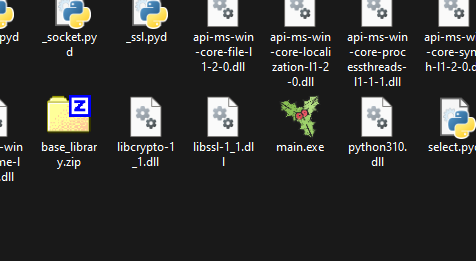
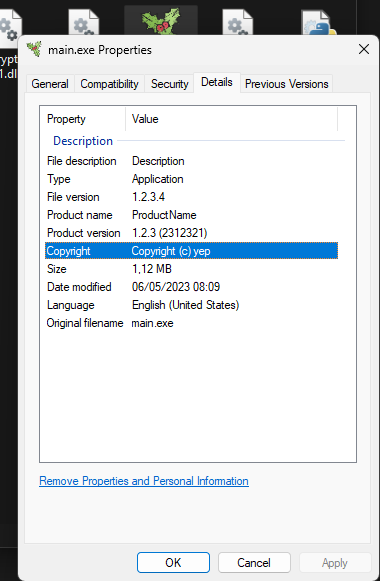
✒️ Signing the Package#
signtool sign /fd SHA256 /n "Rémi MEVAERE" /t http://timestamp.digicert.com .\main.exe
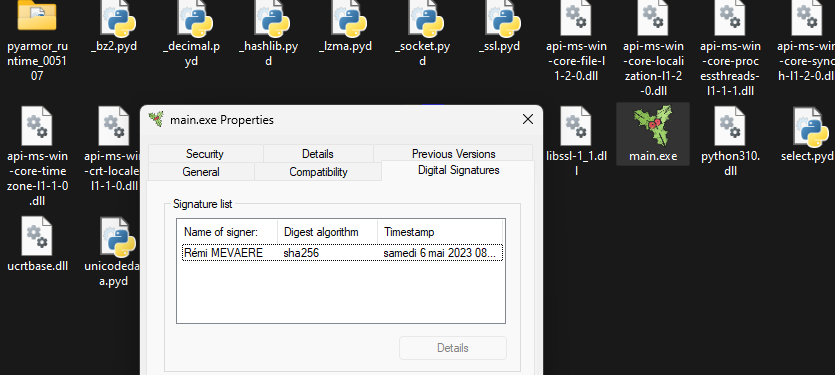
Move the licence file
my_licence.key
🌐Conclusion#
We’ve seen how to protect our python program or some sensitive parts that we don’t want to share ;
Each time, we have to trust an external program (not open-source) ;
Even if it seems strong, with time, method and courage it is possible to crack your program, if the CPU can run the code, the cracker can see it !
Better solution would be to provide the software as a service (I hate that), more updates and a good service ;
It’s not suitable for programs that need maximum resources cause using virtual machine /obfuscation / protection add extra steps to CPU and more memory ;
This article is a good example of how interface C++ Libraries with Python.
Indication
Rémi MEVAERE for sciences-physiques.net the 3 July 2024
PyArmor 8.5.10, Enigma Protector X64 7.60, Python 3.12, PyInstaller 6.8
